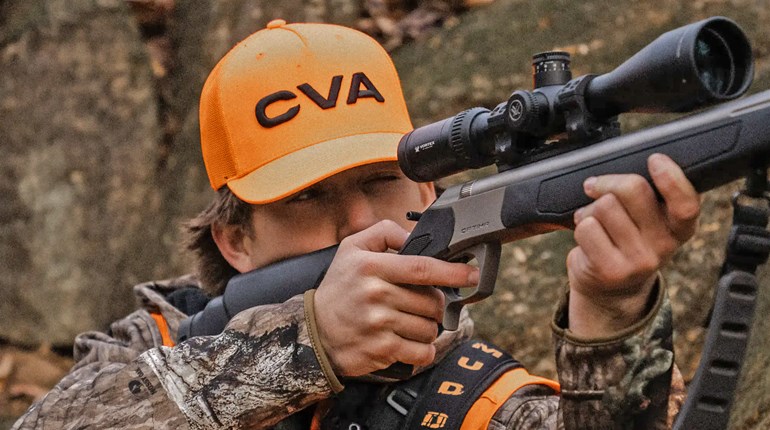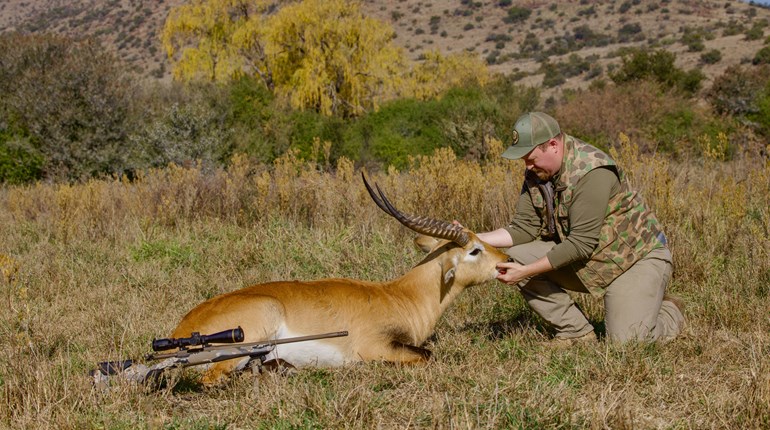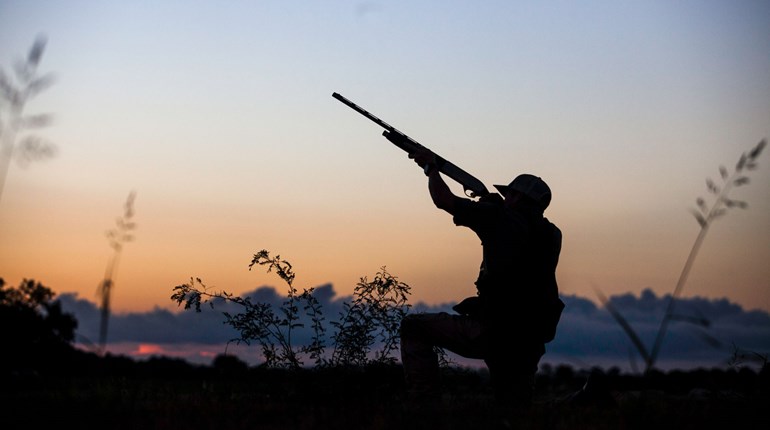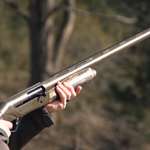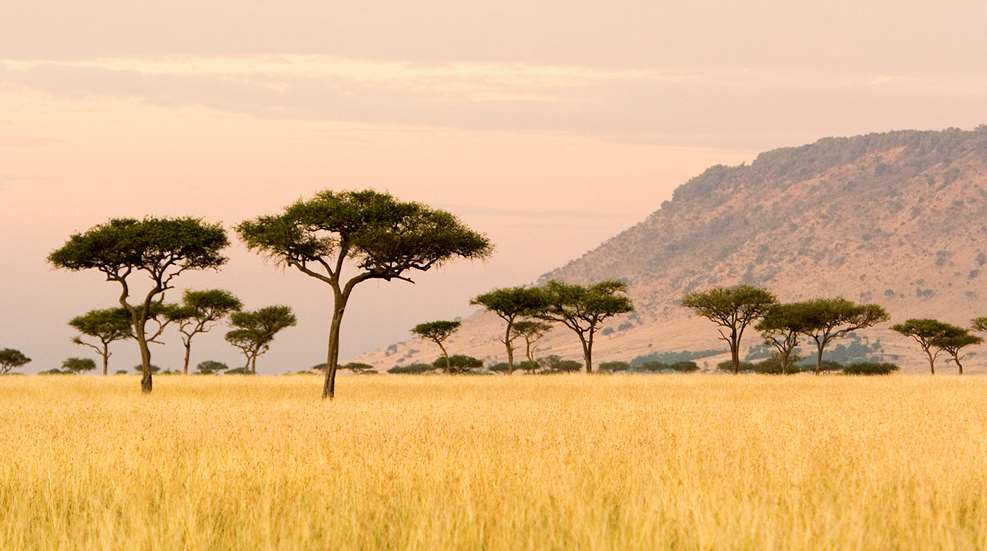
“My fear answer is no,” I said to my husband, Jon. Honestly, as the words crossed my lips, I recognized the answer was absurd. In every other fiber of my being the answer was a vehement “yes.” So, without pause, I said, “I’m thinking I shouldn’t give in to my fear answer. I’m going.” Jon looked at me and beamed.
A few days prior, I had received an invitation from Chad Schearer, director of media relations and marketing for CVA, to join him and his family on a plains-game safari in South Africa. It had always been a dream of mine to go to Africa, but never for the life of me did I think I would actually do so. You see, I hate flying. Most people dislike it to a certain degree, but I truly loathe it. I don’t mind short trips—I can handle a couple of hours—but I start to get real antsy with longer trips. Around hour five I am more than ready to get the heck out of the claustrophobia-inducing metal tube in the sky. Lucky for me, I’ve never had to fly for much longer than that without relief of at least one layover. I’d always wondered how anyone could take those long-haul, 15-hour-plus flights across the ocean. I honestly didn’t think I could survive it. But here I was, with Africa on the horizon. The only thing stopping me was the thought of that horrible flight. I said yes anyway. Apprehension was not going to beat me this time.

As it got closer to launch time, I was becoming increasingly excited, but I still had lingering doubts regarding whether I would be able to survive the plane ride. I was thankful Chad’s wonderful wife, Marsha, who has made the trip to Africa more than a handful of times, gave me plenty of travel and packing tips, and above all, she has a kind, cheerful disposition that is guaranteed to make anyone she talks to immediately feel at ease.
“What if the flight out is so terrible that I decide I just can’t fathom getting back on the plane to come home?” I asked Jon with a nervous laugh on the way to the airport. He chuckled before responding: “Well I guess we’ll just have to cross that bridge when we come to it. Trust me, you’ll be just fine.” I trusted him, sure, but then again, he couldn’t know for certain whether my angst would get the better of me. This one was on me, and there was no backing out now—and no part of me wanted to. Africa, here I come.
■ ■ ■
I was roused from a deep sleep by the bright, bubbly voice of the flight attendant announcing that we were beginning our descent to Johannesburg. How long have I been sleeping? Is it really almost over? I partially lifted my window shade, then promptly slammed it shut when a stream of blinding sunlight burrowed into my unadjusted eyes and threatened to make me the most hated passenger on the plane. What time is it? I clicked on the flight map screen, which displayed the local time: almost 5:30 p.m. It then hit me: The bright light I had just seen was likely the sunset, making it the only sun I would see for more than 24 hours. It’s a strange concept if you have never experienced it, and one I hadn’t considered prior to that moment. Wheels touched down and I turned my phone off airplane mode and sent both Jon and my parents the same text: “Just landed in South Africa, and I survived! Can you believe it?!” It was a feat even I had trouble comprehending, but man did it feel good.

Making it through customs and retrieving our luggage and guns was a unique experience. But Chad and Marsha were familiar with the process, and we had Afton’s Mr. X meet us at the gate, so the whole airport affair—though nerve-wracking to someone who has never been through it—was completed with relative ease. We spent the night at the Afton Safari Lodge, which is located just a few minutes from the airport and specializes in making the process of traveling in and out of the country as seamless as possible for hunters. After a delicious meal and my first African fireside conversation, I settled into bed with visions of plains game dancing around in my head.
The next morning, we departed for our two-and-a-half-hour drive to the Limpopo province. Upon arrival, we were greeted by Egbert Boon, owner of Sensational Hunting Safaris and our PH for the week, who was raised on the concession we would hunt. After settling into our guest cottages, the adventure really began, and we headed to the range to check the zeros on our rifles.

Only minutes after we pulled out of camp in the HiLux, my dreams became reality as we began to see game left and right. Egbert would call them out as he saw them. “Impala,” he’d say as his hand jutted out to point out its location in the bush. “Wildebeest to the right, ah, kudu, to the left of that bush, do you see it?” My head couldn’t swing back and forth quickly enough to get a good look at all we were seeing—more game than I had seen in my life, and all of which I was seeing for the first time. “Oh my gosh, a giraffe! I’ve been dying to see one! I can’t believe it!” I giddily exclaimed while tapping Marsha on the arm. “Look! Another one! And a calf!” Egbert chuckled quietly and slowed the vehicle to a stop. “Pretty cool, aren’t they?” Cool was an understatement. There was a fluid beauty to the way they moved. I could have sat and watched them all day. I felt like a child experiencing the world for the first time—full of wonder and curiosity, taking it all in. The return flight home was the furthest thing from my mind. I’d certainly made the right choice. And to think I’d soon be putting some of these critters in my crosshairs. It was almost heaven.
■ ■ ■
The vehicle slammed to a halt and I lurched forward, bracing myself against the dashboard. “Warthog! Group of them!” Egbert said, while simultaneously throwing up his binocular. “Grab your rifle, let’s go. Quickly! They haven’t seen us, but they likely won’t be there for long.”
I grabbed my rifle and hopped out of the vehicle. The cloud of dust formed by our abrupt stop hadn’t even settled before we were on the move. This is the beauty of hunting in Africa. There is a constant course of adrenaline running through your veins because you never know what will be around the next corner. A safari can literally go from zero to 100 in a split second, which requires you to be ready for game time, at all times. We had walked about 200 yards before Egbert halted and set the shooting sticks. “There! There are two of them, right there!” I placed the CVA Cascade atop the sticks and settled in. “Tell me what you see in your scope,” he whispered. “I see two of them,” I replied, “but they’re partially covered by the grass, and they keep moving … oh, they stopped. I see them.”
“When you’re ready, take the one on the left.” Just as I clicked off my safety, the warthog spun around several times—similar to the way a dog would before lying down—and took several steps to the left. I followed it with my reticle, and while I couldn’t see its head, I had a clear shot at its vitals. Boom. The warthog jumped, and I chambered another round while following it in my scope as it took off to the right and disappeared. I lifted my head and saw one, two, three, four warthogs sprinting through a small opening in the tall grass, barreling out of view. I flipped on the safety of my rifle. “Were there four there?” I asked. Egbert was off and running before he had time to answer. “Come,” he commanded.
Searching the area where we expected to find a dead warthog, we found blood but no warthog. We continued to follow the blood trail, which in short order seemed to be running us in circles. Egbert was now on the phone, speaking in Afrikaans to the other PH, Hanro. “I asked him to come and bring a few trackers,” he said upon hanging up. It really felt like a good shot, I thought to myself, the sweat rolling down my neck now increasing from nervousness more than the midday head. “The warthog was facing left, right?” I said to Egbert. “No, it was facing right,” he responded. My stomach dropped. “Oh my gosh, I thought it was facing left.” I shouldn’t have taken the shot without confirming that. “I feel terrible,” I said.

“Please, no need to feel terrible,” he responded, “These things happen all the time. Not to worry, we will find him.” Great, my first animal in Africa and I have completely botched it.
Fifteen minutes later, Hanro and several trackers arrived and immediately got down to business. Fingers laced behind their backs, bent over close to the ground, every once and awhile stopping and pointing a finger—these guys were incredible to watch. “Blood, blood,” they’d say, while scanning the ground looking for tracks and pointing the other trackers in the direction they should go. I followed closely behind, completely enthralled and utterly speechless at their ability to find even the tiniest speck of blood on a single blade of grass. After almost two hours of tracking, just as my hope was beginning to dwindle to nothing, Egbert motioned for me and pointed to a dinnerplate-sized pool of blood. “Look, he has bedded here recently, we must have pushed him, but he is hurting. We will move very slowly now. Stay close to me, you must be ready in case we jump him.”
We continued trudging through the brush that was growing increasingly thick with each step, Egbert pointing to each new spatter of blood as we inched forward. We had gone about 40 more yards when he half-whispered, “There! There he is!” The warthog jumped up and started to take off. Boom. He was down.

While it certainly wasn’t how I would have liked the scenario of my first animal in Africa to play out, I couldn’t have been more grateful for the talent, determination and hard work of the PHs and the trackers. I learned more about blood trailing in those few hours than I had in all my years of hunting. It is knowledge I will carry with me for the rest of my life.
■ ■ ■
“Come, come,” Egbert whispered while swiftly motioning for me to move closer. We had spotted a group of several sable atop a grassy hilltop about 500 yards away that looked to hold a good bull and we were formulating a plan for how to close the distance without detection.
“Follow very close behind me. We’re going to go around to the far side of this hill and come up on the left side where there is more brush and a few trees to conceal us.” I nodded my head in acknowledgement while attempting to steady my increasing heart rate—a difficult feat when the chance to bag at the animal at the tippy top of my plains-game wish list was, I hoped, just a few hundred yards away.
I followed Egbert’s strategically placed steps through the tall, wheat-colored grass, parting it with my free hand as we pushed through in a crouched position. He stopped abruptly, and I almost ran into him as he slowly turned and placed the shooting sticks down while looking to the right. I turned my head to follow the direction of his eyes and saw them: three sable standing about 120 yards away, one of which was a sizable bull, obvious even to my untrained eyes. I could feel the thump of my own heartbeat in my ears as I placed my rifle on the sticks, all earlier effort to quell its rapid pace proving futile.
“There! He’s on the far right, standing between those two trees,” Egbert whispered. “Do you see him?” I pulled the rifle into my shoulder and peered through the scope. “Yes, I see him. Did he just move his head? He is facing right, correct?” I wanted to be absolutely sure I was looking at the right animal—I had zero desire to go through another warthog saga.
“Yes, and yes, he is facing right, slightly quartered away now,” he replied. “Shoot him when you’re ready.” I clicked off my safety, settled my crosshairs on the bull’s vitals, took a deep breath and squeezed the trigger. The bull lurched and dashed straight into the tree line behind him, out of sight. “Great shot!” Egbert exclaimed.
 A bucket-list sable and a warthog—plus innumerable other memories—never would have been possible if the author hadn’t said “yes” when Africa beckoned.
A bucket-list sable and a warthog—plus innumerable other memories—never would have been possible if the author hadn’t said “yes” when Africa beckoned.
We followed the blood trail from the tree line where we saw him disappear about 30 or 40 yards before Egbert turned to me, smiled and pointed just ahead of us, where I saw the sable lying. I let out an audible gasp as I walked up to him. “They are even more beautiful up close,” I said, as I ran my hands over his impressive set of ringed, arched horns and admired the striking contrast of white facial markings against its glossy, black hide. I bent down beside the animal, and gave thanks to the Lord for its life and the blessings He continually bestows on mine.
■ ■ ■
Sitting at the campfire on my last evening, I was, in fact, dreading the long flight home—not because I didn’t think I would survive it but because I just wasn’t quite ready to leave what had been perhaps the greatest hunting experience of my life.
 The author and CVA’s Chad Schearer pose proudly with a blesbok taken by the CVA Cascade XT. Loaded with Armscore Trophy Class 180-grain AccuBond bullets and topped with a Dead Air Sandman suppressor, the Cascade XT proved to be quiet, easy on the shoulder and deadly accurate on game.
The author and CVA’s Chad Schearer pose proudly with a blesbok taken by the CVA Cascade XT. Loaded with Armscore Trophy Class 180-grain AccuBond bullets and topped with a Dead Air Sandman suppressor, the Cascade XT proved to be quiet, easy on the shoulder and deadly accurate on game.
I’d like to leave you with this: If the experience of a lifetime is one “yes” away, don’t let fear or unfamiliarity be the reason for a “no.” You may never know just how much you could miss. If it’s an Africa safari we’re talking about, it’s a whole lot. I genuinely surprised myself by choosing “yes.” Now I wouldn’t hesitate to choose it a thousand times over—even if it meant another insanely long plane ride. Take the chance. Live while you still can. Trust me, it’s worth it.
CVA Cascade XT
Most hunters are familiar with the CVA name and typically associate it with in-line muzzleloaders, but in 2019 the company introduced its first-ever bolt-action centerfire rifle: the Cascade. I used the new “precision-oriented” Cascade XT model in South Africa, and based on its stellar performance, I’d say CVA has undeniably earned itself a top spot in the centerfire market.
My rifle was chambered in .300 Winchester Magnum and featured a TrueTimber Strata camouflage-finished synthetic stock and a heavier, No. 5 taper 24-inch, 4140 carbon steel barrel with a threaded ⅝x24 muzzle, which I fit with a Dead Air Sandman suppressor. The suppressor not only took the bite out of the .300 Win. Mag.’s recoil but allowed me to shoot at game without spooking nearby animals, meaning my next target could have been right around the corner.

The bolt design incorporates a 70-degree throw for smooth, fast cycling and more scope clearance. A four-round, flush-fit detachable magazine makes loading quick and simple, and with a fully loaded spare in my pocket I was always ready for a quick reload. An extra front swivel stud allows for the use of a sling and a bipod at the same time—a subtle but appreciated feature. The rifle’s length of pull is adjustable via a 1-inch spacer located between the stock and Crushzone recoil pad. The two-position toggle safety is conveniently located on the right side of the action to the rear of the bolt handle, and the bolt can be cycled with the safety engaged.
CVA allows customers to purchase and test the rifle for 14 days to verify its MOA accuracy guarantee. But if your experience is like mine, you won’t send back this rifle. MSRP is $850-875.












